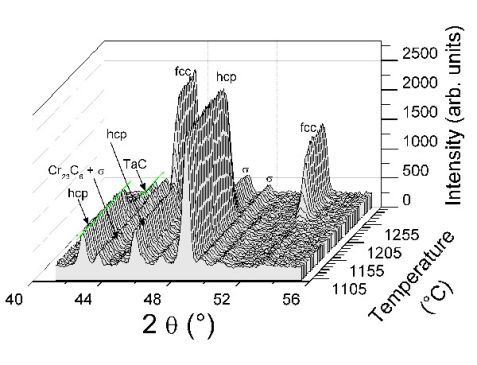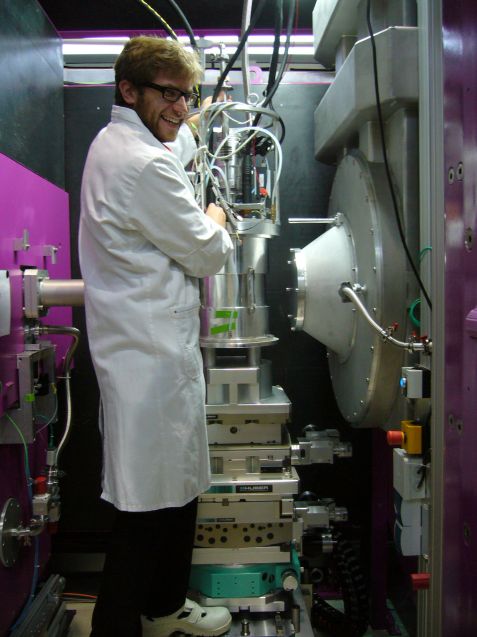MLZ ist eine Kooperation aus:
 > Technische Universität München
> Technische Universität München > Helmholtz-Zentrum Hereon
> Helmholtz-Zentrum Hereon
 > Forschungszentrum Jülich
> Forschungszentrum Jülich
MLZ ist Mitglied in:
 > LENS
> LENS > ERF-AISBL
> ERF-AISBL
MLZ in den sozialen Medien:

MLZ
Lichtenbergstr.1
85748 Garching
Development of Co-Re-based alloys for ultra-high temperature applications in gas turbines
D. Mukherji1, R. Gilles2, L. Karge2, P. Strunz3, and J. Rösler1
1Institut für Werkstoffe, Technische Universität Braunschweig, Braunschweig, Germany
2Heinz Maier-Leibnitz Zentrum (MLZ), Technische Universität München, Garching, Germany
3Nuclear Physics Institute ASCR, Prague, Czech Republic
Co-Re alloy development is prompted by the search for new materials for future gas turbines. Understanding transformation and microstructural stability in the Co-Re-Cr system at high temperatures is essential for successful alloy development. In-situ neutron and synchrotron measurements are being used extensively for this purpose. A joint DFG project with TU-Braunschweig (alloy developer) and MLZ (providing neutron methods) was recently started to study the strengthening TaC precipitates (10 – 60 nm size). In particular, the influence of the C to Ta ratio in the Co-Re alloy is being investigated to optimize the alloy strength and long-term stability at high temperatures.
Future gas turbines need new high temperature alloys
The Co-Re based alloys are a new class of high temperature alloy designed and developed at the Technische Universität Braunschweig [1] for applications in future gas turbines as the current workhorse Ni-superalloys are reaching their limits. In order to increase application temperatures, the melting point of Co-based alloys was enhanced by adding the refractory element Rhenium and the first Co-Re-based alloy with a melting range of more than 200 °C greater than that of the single crystal Ni-superalloys was introduced in 2007 [2]. The Re addition stabilizes the ε-Co (hcp) phase as matrix, in contrast to the commercial co-alloys currently used where the matrix is γ-Co (fcc).The alloys are mainly strengthened via carbides, particularly the MC carbides of type TaC. Neutron facilities at FRM II, BER II, PSI and BNC were widely used to study the composition and phase structures in Co-Re alloys [3, 4]. Complementary diffraction and small angle scattering measurements, especially in-situ at high temperatures, were performed at the FRM II, where the hysteresis in the hcp ⇄ fcc phase transformation in the Co matrix phase was observed for the first time in a Co-Re-Cr-Ta-C alloy at temperatures above 1200 °C [5]. Figure 1 shows the diffraction peaks of the different phases and their evolution with increasing temperature from 1100 to 1300 °C in a 3D-plot, where the Co matrix transformation is clearly seen.
In-situ SANS characterize fine dispersion of strengthening TaC precipitates
Evolution of the TaC precipitates during a heat treatment cycle was monitored and selected results from in-situ SANS measurements during holding at temperatures of 1400, 1200 and 1100 °C are shown in figure 2. The small TaC precipitates give a strong scattering contribution and the change in their size and volume fraction is clearly visible in SANS. The alloy was first heated to 1400 °C, where all fine precipitates (< 100 nm) were dissolved. Subsequent stepwise cooling from 1400 °C and holding at different temperatures of interest in the application temperature range of the alloy shows that fine TaC re-precipitates during hold at 1100 °C and the small particles grow to a size of approximately 60 nm and their volume fraction continuously increases. The experimental set up at SANS-1 is shown in figure 3.
References:
[1] D. Mukherji et al., J. Phys: Conf. Ser. 240, 012066 (2010).
[2] J. Rösler et al., Adv. Eng. Mater. 9, 876 (2007).
[3] D. Mukherji et al., Metall. Mater. Trans. A 44, 22 (2013).
[4] R. Gilles et al., J. Phys: Conf. Ser. 340, 012052 (2012).
[5] D. Mukherji et al., Mater. Lett. 64, 2608 (2010).
MLZ ist eine Kooperation aus:
 > Technische Universität München
> Technische Universität München > Helmholtz-Zentrum Hereon
> Helmholtz-Zentrum Hereon
 > Forschungszentrum Jülich
> Forschungszentrum Jülich
MLZ ist Mitglied in:
 > LENS
> LENS > ERF-AISBL
> ERF-AISBL
MLZ in den sozialen Medien:





